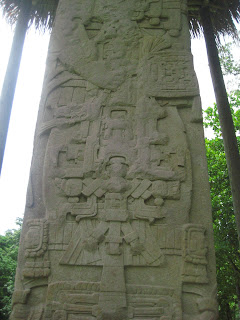Quirigua is another ancient Maya site that I was able to visit while in Guatemala for the first time. It is a much smaller site than Copan, but the magnificent stelae here are truly spectacular as they are material manifestations of kingship. The site is found in the department of Izabal in southeastern Guatemala and is, in my humble opinion, completely worth a visit (some people do not visit Quirigua because it is not as well known as Copan (Honduras) or other Maya sites in Guatemala). Figurines and other archaeological materials suggest that the site was occupied as early as 400-200 BC. Hieroglyphics, architecture, and chemical tests from Tikal, Copan and Quirigua suggest that Copan and Quirigua were founded by elite colonists from Tikal. During the Classic Period (A.D. 250-900), Quirigua sat at a critical juncture of several trade routes. Quirigua was a vassal state of Copan, but eventually broke free of Copan and became its own political entity. K'ak' Tiliw Chan Yopaat is perhaps Quirigua's most famous and powerful ruler who, in 738, captured Copan's ruler, 18 Rabbit (Uaxaklajuun Ub'aah K'awiil) and beheaded him! Quirigua's independence was thereby established. In one of these pictures I am standing next to the tallest stone monument of the New World.

The Motagua River flows from the western Guatemalan highlands and Quirigua occupied a strategically beneficial position to control the exchange of uncut jade from the Motagua source of jade as well as the ability to control the trade of cacao. Quirigua sits at a crossroads to the Caribbean and between Copan and the Peten basin (where Tikal and other major Maya sites are located). I believe these first two pictures are of Altar M, which dates to AD 734, and has been described as a feline, a crocodile, or a snake-like figure and could possibly represent a toponymic glyph (a place-name glyph).

The tree to the right in this photo, without a lot of foliage, is a ceiba tree, which is the cosmic world tree, a sacred and highly significant tree for the ancient Maya.

This is perhaps one of the most famous sculpted monuments in the ancient Maya world. I believe this is "Zoomorph P"(what a great name, right?). A ruler named Sky Xul (Shuul) evoked the previous and mighty ruler K'ak' Tiliw Chan Yopaat in this monument commissioned in AD 790. This zoomorph represents the crocodilian Cosmic Monster with a personified mountain on its back (Matthew Looper, 2003: 188 in "Lightning Warrior: Maya Art and Kingship at Quirigua"). Sky Xul started a new sculptural program of architectural space in a court located to the northeast of the main acropolis. K'ak' Tiliw Chan Yopaat figures prominently in the text, a clear "attempt to compare the two rulers." 

Here are a few more photos from the highlights of Quirigua. It is always so fascinating to me to contemplate the work, dedication, and artistic creativity it definitely took in order to sculpt and carve these not-so-humble monuments to various rulers of Quirigua. I love the so-called "full-figure" glyphs that were sometimes substituted for the regular glyphs in order to add variation and sophistication to an already elegant writing system. To be given the opportunity to stand in front of these stelae and other carved monuments at Quirigua was, indeed, a wonderful experience for me!!

I believe this is Stela C, south face, dedicated in 775. Another monument that demonstrates royal portraiture at the small but incredibly fascinating ancient Maya site of Quirigua.

















0 comments:
Post a Comment